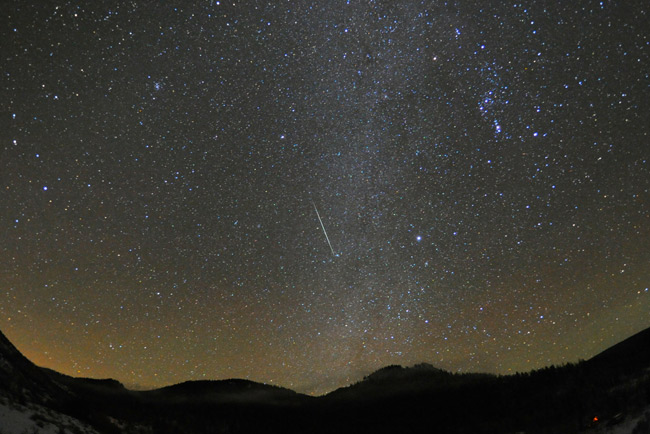
The annual Draconid meteor shower will hit its peak Saturday (Oct. 8), but skywatchers may not get much of a light show.
While the normally tame Draconid meteor shower will be exceptionally active this year, the fireworks should be drowned out by sunlight in North America and a bright moon in Europe and Asia, experts say. So stargazers under dark skies may still want to look up on Saturday, but they shouldn't let their hopes get too high.
"It's not going to be that dramatic," said Bill Cooke of the Meteoroid Environment Office at NASA's Marshall Space Flight Center in Huntsville, Ala. "People in North America aren't going to see anything." [Photos: The Perseid Meteor Shower of 2011]
The Draconids rev up
Like other meteor showers, the Draconids — so named because they appear to radiate from the constellation Draco — result when Earth plows through debris streams shed by a comet on its path around the sun. These comet bits become meteors, or shooting stars, when they burn up in Earth's atmosphere.
In the Draconids' case, the parent comet is called Giacobini-Zinner, so the Draconids are also known by another name: the Giacobinid meteor shower.
Most years, the Draconids are weak and faint, with peak meteor rates of about 10 per hour. That's barely above the normal background rate of shooting stars, and a far cry from consistently dramatic showers like August's Perseid meteor shower display.
Get the Space.com Newsletter
Breaking space news, the latest updates on rocket launches, skywatching events and more!
But this year, Earth will encounter especially thick cometary debris streams, revving up the Draconids considerably.
"Rates are projected to be 500 to 1,000 per hour," on Oct. 8, Cooke told SPACE.com in an email.
Unfortunately, the shower should peak around 1 p.m. or 2 p.m. EDT (1700 or 1800 GMT), meaning the sun's glare will wash it out in the Western Hemisphere.
A nearly full moon
Stargazers on the other side of the world will at least have dark skies during the Draconids' peak. But conditions will be far from ideal in the Eastern Hemisphere, Cooke said, because the moon will be about 90 percent full on Oct. 8.
"The moonlight is going to wash out most of the meteors," he said.
Some of the best places to watch the Draconids this year are spots around the Mediterranean or the Middle East, he added. These regions will likely have clear skies, while Northern Europe tends to be cloudy at this time of year.
"But don't go if you're expecting to see lots of meteors, because the Draconids are faint, and that full moon will disappoint you," Cooke said.
Editor's note: If you snap amazing Draconid meteor photos you'd like to share for a possible story or image gallery, please contact managing editor Tariq Malik at tmalik@space.com.
You can follow SPACE.com senior writer Mike Wall on Twitter: @michaeldwall. Follow SPACE.com for the latest in space science and exploration news on Twitter @Spacedotcom and on Facebook.
Join our Space Forums to keep talking space on the latest missions, night sky and more! And if you have a news tip, correction or comment, let us know at: community@space.com.

Michael Wall is a Senior Space Writer with Space.com and joined the team in 2010. He primarily covers exoplanets, spaceflight and military space, but has been known to dabble in the space art beat. His book about the search for alien life, "Out There," was published on Nov. 13, 2018. Before becoming a science writer, Michael worked as a herpetologist and wildlife biologist. He has a Ph.D. in evolutionary biology from the University of Sydney, Australia, a bachelor's degree from the University of Arizona, and a graduate certificate in science writing from the University of California, Santa Cruz. To find out what his latest project is, you can follow Michael on Twitter.









